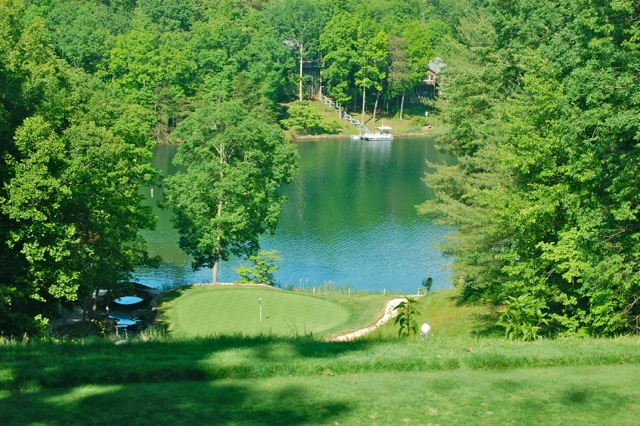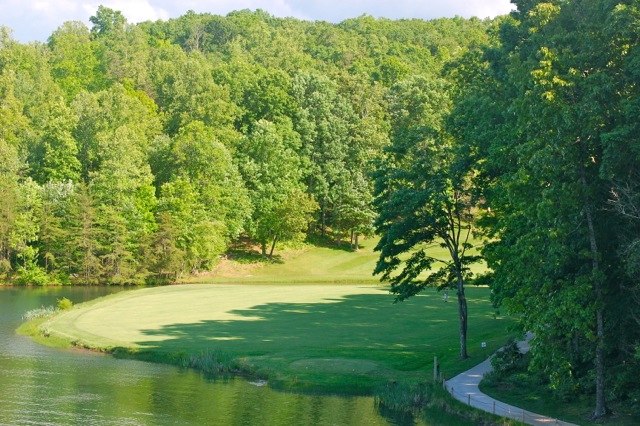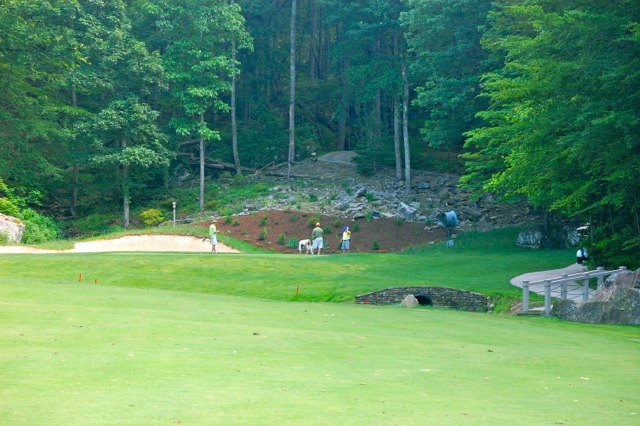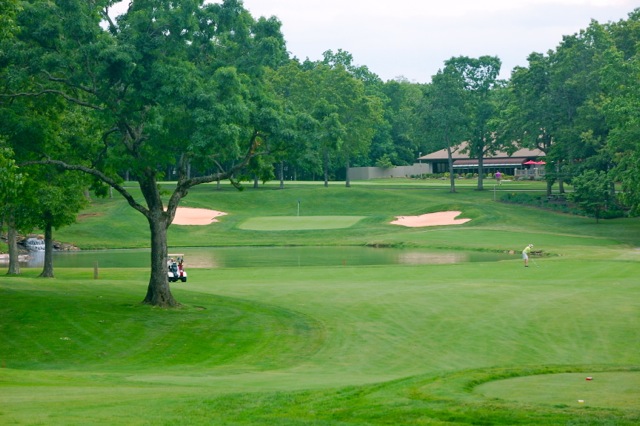The sprawling community of Fairfield Glade, located on the Cumberland Plateau almost midway between Nashville and Knoxville, TN, has been on my list for a visit for some years now. On a drive from Memphis to our vacation home in Pawleys Island, SC, I couldn't avoid a stop, since the community is just a few miles off the major east/west Interstate 40. It was a short visit, just enough to take advantage of Stonehenge Golf Club professional Jeff Houston's kind invitation to play what most local golfers believe is the best of Fairfield Glades' five courses. The biggest challenge at the par 3 14th hole at Stonehenge is club selection from 10 stories or so above the green.
The biggest challenge at the par 3 14th hole at Stonehenge is club selection from 10 stories or so above the green.
Bent grass greens, a golfer's favorite
A site of the state's Women's and Senior Opens, Stonehenge is both challenging and in fine condition as befits a tournament-ready layout. The greens were medium fast and smooth, with plenty of contours. (Stonehenge is far enough north to maintain bent grass greens, most every player's favorite putting surface.) One otherwise routine par 5 featured a long green that ran front left to rear right up a severe slope that I failed to get over after hitting the green in regulation. My second putt, still up the hill, was about 30 feet which I misread, leading to my first four-putt in 10 years. Indeed most of the challenge at the rather short layout – 6,549 yards from the tips – was around and on the greens.
The front and back nines at the Joe Lee designed Stonehenge, as is often the case, are two entirely different experiences; the front is a fairly conventional layout, showcasing designer Lee's experience in Florida, with trees rather than powder sand bunkers defining the crook of a few interesting doglegs. The back nine was more visual if not more challenging; once warmed up from the two-hour drive from Nashville, I improved seven strokes on the inward nine. Two holes in a row on the final nine

 The 15th tee is high above a fairway that is bounded by a lake front and left, woods on the right and a stream at the far edge (top). After a successful drive, the play is down the left side, to leave the best angle into a long, uphill green that runs from front left to back right.
The 15th tee is high above a fairway that is bounded by a lake front and left, woods on the right and a stream at the far edge (top). After a successful drive, the play is down the left side, to leave the best angle into a long, uphill green that runs from front left to back right.
Playing for position
Following that par 3, the winding cart path leads up to a four-story-high elevated tee above a corner of the lake. The drive on the 15th – long hitters will step down to a 3- or 4-wood – is to about a 100-yard long patch of land surrounded by lake and a stream at its end, nearly 250 yards out. The stream would be out of reach of most of us, but it is hard to calculate how much extra distance the elevated tee promotes. The layup second shot is over the stream and must find its way to the left half of the fairway for any reasonable approach to the aforementioned green, the one I four-putted. It's a beautiful hole that demands patience on the first two shots and some boldness on the next two, especially if the pin is in the back portion of the green, above the sharp rise, as it was on this day.
The most imposing remaining challenge is the finishing hole, a par four with a large pond directly in front of the green and a tree standing sentinel at the front left of the pond. Any tee shot pulled left is bound to wind up behind that tree, blocking any direct route to the green. It is not a long or particularly difficult hole, if your drive is center or right on the fairway. You have a good view of the 19th hole above the green, a welcome sight at the end of any hard-played round. (Although at lunch before the round, we could not see any part of the green or the heads of golfers from our perch in the restaurant.) With a tee shot that avoids the trees on the left at #18, the hill behind the green gives comfort that you can take one extra club to be sure to clear the pond.
With a tee shot that avoids the trees on the left at #18, the hill behind the green gives comfort that you can take one extra club to be sure to clear the pond.
Pay as you play
Fairfield Glade offers two approaches to golf membership. One is not membership at all; rather, any resident, through their membership in the homeowner's association, receives a discount for play on the community's five golf couress, $30 (wallking permitted, cart fee $12). For $2,800 annually, a couple can play all the golf they want. (Golf professional Jeff Houston says 100 rounds is about the break even point.) All the community's golf courses are open to members of the public, who pay a higher fee but still not an outrageous one. Of course, with no vested interest in the condition of a course they may play once or, at most, occasionally, many members of the public do not fix ball marks or replace divots, a fact well in evidence on the day I played. (I fixed an average two to three per hole.) To its credit, Fairfield Glade has not yet followed the lead of other multi-course complexes by invoking economies of scale in the running of its separate golf clubs; each of the four clubs – one includes 36 holes of golf – maintains its own golf pro, an expense that showed in the smooth operations at Stonehenge on what seemed like a busy day.
Because winter temperatures can dip into the 30s or lower December through February, Fairfield Glade may not be a strong lure to folks looking to play golf year round, although plenty of couples maintain their full-time residence in the community. But as noted in an earlier article, Fairfield Glade is a summer magnet for many who spend their winters in Florida. At elevations reaching up to 2,000 feet, the area offers temperature relief during hot summers. (The Florida couple I played golf with noted also that their golf balls seemed to fly a little farther than they were used to at sea level.) July is the hottest month of the year at Fairfield Glade, and yet the average high is just 83 degrees.
Nice choices of homes at less than $100 per square foot
What makes Fairfield Glade especially attractive as a second-home destination is the low cost of living, especially the real estate prices. Our couple from Florida started off looking for a condominium to complement their single-family home in Clearwater, but when they saw the prices for detached homes along the Stonehenge Golf Course, they bought one of those. A scan of single-family homes in Fairfield Glade reveals a considerable number priced at less than $100 per square foot. One example: A two-bedroom, two-bath, 2,000 square foot ranch on the lakefront, with taxes of less than $700 per year and homeowner association dues of just $92 per month. And for those who decide to stay in Tennessee for six months and a day or more, there is no state income tax.
If Fairfield Glade sounds like your kind of golf community, please contact me for more information and an introduction to a local real estate agent who specializes in properties there.



